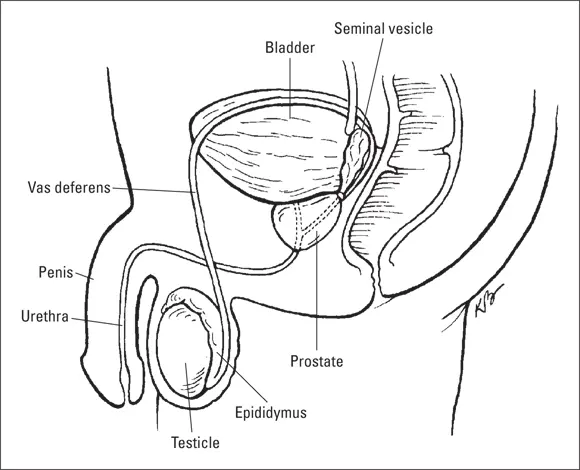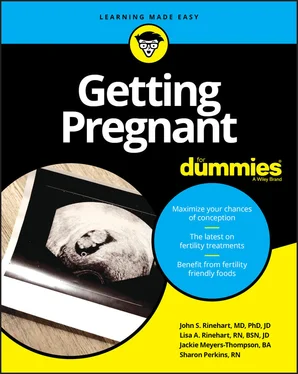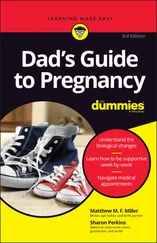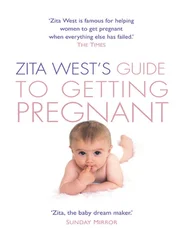Bleeding too infrequently or skipping periods
Cycles that are very long, over 35 days apart, can indicate that you’re not ovulating regularly. This can be a factor of excessive exercise, weight change, or other factors, but it can also be caused by polycystic ovary syndrome, or PCOS. PCOS can cause changes in hormone ratios that can be diagnosed by your doctor, as well as physical changes such as excessive hair, weight gain, and acne. (See Chapter 7for more on PCOS.)
Endometriosis, premature ovarian insufficiency (see Chapter 7for more on both of these), abnormal thyroid levels, or high prolactin levels (see Chapter 11for the details on diagnosing infertility causes through blood tests) can also cause irregular or absent periods.
Bleeding between periods can indicate that something is wrong inside your uterus or that your hormones are out of balance. Some of the things that can go wrong with your uterus to cause irregular bleeding are
Cervical irritations or infections: Possible causes of cervical bleeding especially if this occurs after intercourse
Fibroids: Benign growths found in the uterine wall
Polyps: Small fleshy growths found on the endometrium, the lining of the uterus, or the cervix
Bleeding too heavily (menorrhagia)
Bleeding too heavily and passing clots can be “normal” for some women, especially in women who are overweight. Fibroids, PCOS, and irregular periods can be related to heavier-than-normal bleeding. Heavy bleeding can also be a sign of recurrent early miscarriage (see Chapter 13).
Women who bleed heavily every month are at risk for becoming anemic (having a decreased number of red blood cells). Anemia can lead to fatigue and weakness, so heavy periods should be checked out with your doctor. A simple blood test can diagnose anemia.
If your period is very light, it could be a normal variant (in which case, lucky you!), or it could be a sign that your uterine lining isn’t getting as thick as it should. Scant periods are typical if you’re using birth control pills or have just stopped using them, or if your periods have just started. If your lining isn’t thickening properly, you may not be ovulating normally, so seeing your doctor is a good idea.
Experiencing painful periods (dysmenorrhea)
Up to 40 percent of women experience pain with their periods, called dysmenorrhea. Dysmenorrhea falls into two categories:
Primary dysmenorrhea has no other underlying cause besides the release of prostaglandins (chemicals made by cells that have specific functions such as controlling body temperature, stimulating smooth muscle, and influencing heat cycles) in the uterus, which cause uterine contractions.
Secondary dysmenorrhea is caused by disease present in addition to the normal release of prostaglandins, such as endometriosis, fibroids, or infection.
 Because painful periods can be caused by diseases that can interfere with getting pregnant, such as endometriosis, you should always see your doctor if you have painful periods. Dysmenorrhea is the most common symptom of endometriosis, which affects over 5 million women in North America and may cause infertility in up to 30 to 40 percent of its sufferers.
Because painful periods can be caused by diseases that can interfere with getting pregnant, such as endometriosis, you should always see your doctor if you have painful periods. Dysmenorrhea is the most common symptom of endometriosis, which affects over 5 million women in North America and may cause infertility in up to 30 to 40 percent of its sufferers.
The release of prostaglandins that cause cramping can also cause nausea, diarrhea, and exhaustion, just to make you feel really terrible during your periods. Taking anti-inflammatory medications such as ibuprofen can help with the symptoms.
Hanging Out with the Guys
Compared to women, guys let it all hang out, reproductively speaking. The external male reproductive organs include the penis, scrotum, and the testicles. Take a look at what every guy should have. See Figure 2-2 for a graphic portrayal of your average man.

Illustration by Kathryn Born
FIGURE 2-2:The male reproductive organs.
The number-one guy concern is probably related to penis size: How do I compare to everyone else? For those obsessed, here are the standards: normal length when flaccid, or limp, 3.9 inches; stretched (still limp), 4.8 inches; erect, 5 to 7 inches, with an average erect size of 5.1 inches. We hope that bit of info made most of you fellows feel better. A small penis, less than 1.9 inches limp, is usually able to impregnate as long as it can get the sperm into the vagina, up toward the cervix. Size is rarely an issue in infertility.
Size may not matter, but function does. If you have seen commercials for erectile dysfunction (ED), you may be comforted to know that even athletes and famous men have problems with erectile dysfunction (ED), also known as impotence. As nice as it is to know that you’re not alone, this condition can be an embarrassing detriment to getting pregnant. Impotence, the inability to have or sustain an erection, is more common as men get older; as many as 50 percent of men between the ages of 40 and 70 have had problems with impotence. Impotence can be caused by diseases such as diabetes or by chronic conditions, such as alcohol abuse, or it can be a side effect of medications. (We discuss impotence in Chapter 12.) ED can be a problem that occurs as patients move through treatment for infertility. Performance anxiety and the sterile nature of fertility treatments may cause ED. Adjusting the environment or using frozen sperm specimens collected under less stressful conditions can help reduce ED.
 The opening that lets both urine and sperm out of the penis should be at the tip of the penis, located dead center. Two types of variations can cause problems getting pregnant. One in around 300 men has hypospadias, which means that the opening is on the underside of the penis. In 20 percent of cases, this problem is hereditary. Epispadias occurs far less frequently; only 1 in approximately 100,000 men has epispadias. In epispadias, the opening is on the top of the penis. Both conditions are associated with an unusual curvature of the erect penis; it curves up in epispadias and down in hypospadias. Both conditions can prevent the sperm from getting exactly where they need to be. Surgical correction is possible, and inseminations can also help get the sperm to where they need to go.
The opening that lets both urine and sperm out of the penis should be at the tip of the penis, located dead center. Two types of variations can cause problems getting pregnant. One in around 300 men has hypospadias, which means that the opening is on the underside of the penis. In 20 percent of cases, this problem is hereditary. Epispadias occurs far less frequently; only 1 in approximately 100,000 men has epispadias. In epispadias, the opening is on the top of the penis. Both conditions are associated with an unusual curvature of the erect penis; it curves up in epispadias and down in hypospadias. Both conditions can prevent the sperm from getting exactly where they need to be. Surgical correction is possible, and inseminations can also help get the sperm to where they need to go.
Testicles are the sperm production and warehouse site. Here, as in many other places on the human body, nature has been generous and given two of the same body part (testicles, in this instance), in case something happens to one. Testicles first develop inside the abdomen and gradually descend outside the body by the time a baby boy is born. At birth, about 4 in 100 boys have undescended testicles, properly called cryptorchidism. Testicles need to be kept a few degrees cooler than 98 degrees for sperm to develop properly, so to prevent future infertility, doctors usually recommend surgery to lower the testicles outside the body as soon as the baby is a year old.
The testicles are contained in a pouch of skin called the scrotum. In about 80 percent of men, the left testicle is bigger and hangs lower. Sometimes the scrotum is abnormally large, which can be caused by a hydrocele (a collection of fluid inside the scrotum), or by a varicocele (dilated or varicose veins in the scrotum). These conditions can be surgically corrected. If left alone, they can raise the temperature of the testes and may cause infertility.
Читать дальше

 Because painful periods can be caused by diseases that can interfere with getting pregnant, such as endometriosis, you should always see your doctor if you have painful periods. Dysmenorrhea is the most common symptom of endometriosis, which affects over 5 million women in North America and may cause infertility in up to 30 to 40 percent of its sufferers.
Because painful periods can be caused by diseases that can interfere with getting pregnant, such as endometriosis, you should always see your doctor if you have painful periods. Dysmenorrhea is the most common symptom of endometriosis, which affects over 5 million women in North America and may cause infertility in up to 30 to 40 percent of its sufferers.
 The opening that lets both urine and sperm out of the penis should be at the tip of the penis, located dead center. Two types of variations can cause problems getting pregnant. One in around 300 men has hypospadias, which means that the opening is on the underside of the penis. In 20 percent of cases, this problem is hereditary. Epispadias occurs far less frequently; only 1 in approximately 100,000 men has epispadias. In epispadias, the opening is on the top of the penis. Both conditions are associated with an unusual curvature of the erect penis; it curves up in epispadias and down in hypospadias. Both conditions can prevent the sperm from getting exactly where they need to be. Surgical correction is possible, and inseminations can also help get the sperm to where they need to go.
The opening that lets both urine and sperm out of the penis should be at the tip of the penis, located dead center. Two types of variations can cause problems getting pregnant. One in around 300 men has hypospadias, which means that the opening is on the underside of the penis. In 20 percent of cases, this problem is hereditary. Epispadias occurs far less frequently; only 1 in approximately 100,000 men has epispadias. In epispadias, the opening is on the top of the penis. Both conditions are associated with an unusual curvature of the erect penis; it curves up in epispadias and down in hypospadias. Both conditions can prevent the sperm from getting exactly where they need to be. Surgical correction is possible, and inseminations can also help get the sperm to where they need to go.










